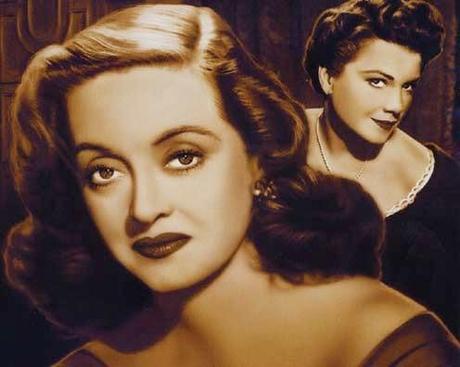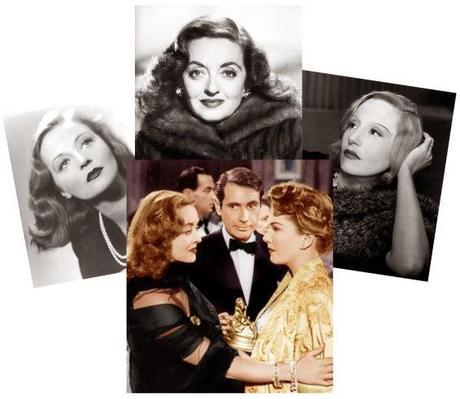 In black-and-white, from left: Tallulah Bankhead, Bette Davis and Elisabeth Bergner; front and center: Bette Davis, Gary Merrill and Anne Baxter in a color still for All About Eve (1950)
In black-and-white, from left: Tallulah Bankhead, Bette Davis and Elisabeth Bergner; front and center: Bette Davis, Gary Merrill and Anne Baxter in a color still for All About Eve (1950)In the spring of 1987 Joseph Mankiewicz was staying at the Hotel Cipriani on the lagoon in Venice, Italy, where he had come to be honored with a prestigious Leone d'Oro award. While there he received an unexpected call one day from a woman he described as "absolutely desperate-sounding." What she said to him came as a surprise - and he didn't believe her:
"Mr. Mankiewicz, this is Eve...the Eve you wrote the movie about. I was the girl who stood outside the theater..."
~
Nearly 40 years earlier, in 1950, Mankiewicz had directed and penned the screenplay for the bewitching and bitchy satire that came to be known as his masterpiece: All About Eve, winner of six Academy Awards including Best Picture, Best Director and Best Screenplay. A sophisticated and cautionary tale of a celebrated Broadway actress named Margo Channing and the unscrupulous 'fan' known as Eve Harrington who finesses her way into the great star's life, All About Eve was nominated for 14 Oscars, topping the record held until then by Gone with the Wind. Bette Davis delivered one of her great star turns as Margo and saw her career exhumed. George Sanders was blessed with a plum role, the part of a lifetime, and an Oscar for his performance as theater critic Addison DeWitt. And for then-starlet Marilyn Monroe came the chance to shimmer, if only for a few moments, in her first A-budget 'prestige' film.
All About Eve's everlasting reputation as a classic among classics rests heavily on Mankiewicz's very smart screenplay and direction, its three larger-than-life central characters (Channing, Harrington and DeWitt) and the solid performances of its ensemble cast members.
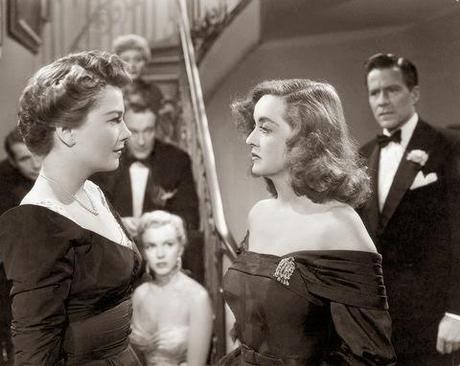
In the background, from left: Gary Merrill, Celeste Holm, George Sanders, Marilyn Monroe and Hugh Marlowe; in the foreground, Anne Baxter (Eve Harrington) and Bette Davis
From the beginning there had been whispers that the story of an older, established actress who is duped by a young ambitious one willing to do anything to succeed had been taken from real life. Joe Mankiewicz hadn't conceived his screenplay out of thin air, it was based on a story that had appeared in Cosmpolitan (then a literary magazine) in 1946. Titled The Wisdom of Eve, the short story was written by Mary Orr, a young actress herself, who received no screen credit for her original work. Well, the story wasn't quite originally hers.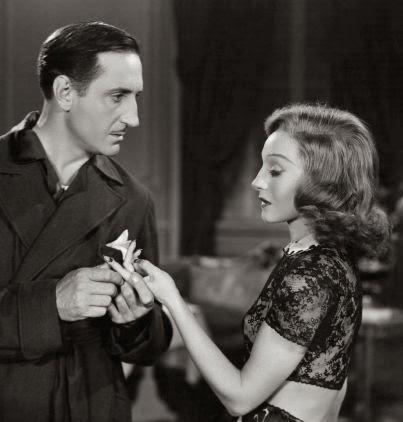
Elisabeth Bergner and Basil Rathbone in Paris Calling (1942)
From 1943 to 1944, Mary Orr's future husband, Reginald Denham, had directed The Two Mrs. Carrolls during its run on Broadway. The star of the play was Elisabeth Bergner, a much-honored, Oscar-nominated Viennese actress known as "the Garbo of the stage" in Europe. Bergner had made films in Germany but was filming in London when the the Nazis came to power and decided it would be wise to stay in England. There she starred in The Rise of Catherine the Great (1934) with Douglas Fairbanks, Jr., Escape Me Never (1935), for which she received a Best Actress Oscar nomination (a Hollywood remake starring Ida Lupino was released in 1947), As You Like It (1936) with a young Laurence Olivier, and Stolen Life (1939) with Michael Redgrave, (re-made in the U.S. in 1946 as A Stolen Life starring Bette Davis). Bergner and her husband, director Paul Czinner, came to the U.S. in 1940. She made Paris Calling for Universal with Randolph Scott and Basil Rathbone in 1942, but it was not a hit and she shifted her focus to stage work.A few months after The Two Mrs. Carrolls closed, in the summer of 1944, Mr. Denham and Miss Orr paid a visit to Elisabeth Bergner and her husband at their rented home in the New Hampshire. That evening, when the women were alone in the kitchen - Bergner was whipping up Wienerschnitzel, Orr was observing - the older actress began to talk about something that had occurred during the play's production. She spoke of a young woman she referred to as "that awful creature," a girl she had first noticed standing in an alleyway next to the theater. The girl had been conspicuous because she wore a red coat and because she was there every night.
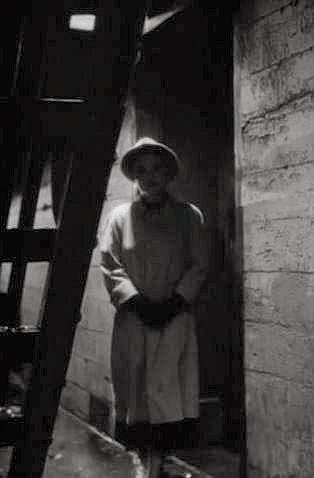
"Eve" in the shadows, in an alley
Bergner told Orr that she eventually invited the girl into her dressing room, touched by her apparent devotion. The girl, whose name was Ruth Hirsch, soon became an assistant to Bergner and secretary to her husband. The couple came to learn that Ruth aspired to be an actress and helped her get permission from Actors' Equity to make her debut on Broadway. The girl seems to have had some talent because she went on to win a John Golden Award, an annual theatrical prize given to young actresses, that same year.What actually took place while Ruth Hirsch was part of the Bergner/Czinner entourage will never be known for certain, but Bergner complained bitterly to Orr that the girl had been deceitful, schemed behind her back and even attempted to seduce her husband.
As Mary Orr and Reginald Denham drove back to their hotel after dinner that night she repeated Bergner's story to him and asked if he remembered a girl in a red coat who'd lingered by the stage door during the run of The Two Mrs. Carrolls. He did, and he also recalled that the girl came to nearly every performance. The next morning Denham suggested to Orr, who had already done a little writing, that she put Bergner's story on paper. "It's a hell of a story," he said.
The Wisdom of Eve was published in the May 1946 issue of Cosmopolitan and in January 1949 Orr's radio play version of the story was performed on NBC's Radio Guild Playhouse. Presently, Hollywood came knocking.
~
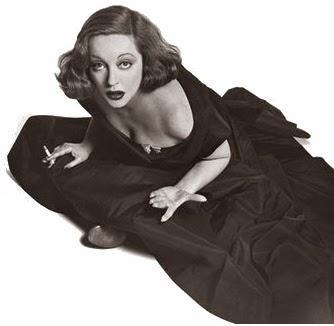
Tallulah Bankhead
A painful but, in the end, felicitous thing happened to the leading lady just before filming of All About Eve was about to begin. Bette Davis had a long, very loud argument with her estranged/soon to be ex-husband and the quarrel left her throat raw and bleeding. When she arrived on the set she could only speak in a ragged near-whisper. She was beside herself, but Joe Mankiewicz liked the effect of what he called Bette's "bourbon contralto" and urged her to continue using the voice even after she healed. Bette noted that she sounded an awfully lot like Tallulah Bankhead, whose distinctive basso tones were known to be authentically and thoroughly whiskey-soaked.Miss Bankhead, whose stage and film career had already plateaued, happened to have a radio show on NBC at the time the film was released. One night, while on the air, she was asked if she had seen All About Eve and her dry reply was, "Every morning when I brush my teeth." She was convinced that the mercurial and flamboyant Margo Channing had been based on her. She would make oblique commentary on Bette Davis's characterization of Margo in her 1952 autobiography with sly reference to "busybodies" who believed Bette had patterned her Margo on Tallulah, emulating everything about her including her 'bark and bite.'
In 1952 Tallulah finally had her chance to play Margo. It was a radio adaptation of All About Eve that, interestingly, co-starred Mary Orr as Karen Richards, Celeste Holm's film role. According to Orr, Tallulah approached her after a rehearsal and asked her point-blank if Margo had been based on her. Orr said no, that the character was modeled on Elisabeth Bergner. Tallulah was livid and, outside rehearsals, never spoke to Orr after that. Perhaps Tallulah had believed that it was more than her persona and style that had been the inspiration for Margo, but the fact that she had once hired a young fan as her personal assistant was simple coincidence. Ruth Hirsch worked for Bergner for only a matter of months, whereas Tallulah's aide was with her for decades - and had never been an aspiring actress.
Mary Orr may not have had Tallulah Bankhead in mind when she created Margo (called Margola in her story), but Joseph Mankiewicz's screenplay was by no means a strict adaptation of The Wisdom of Eve. He'd kept the plot line and most of the central characters, but what he wrote for the screen was signature Mankiewicz, beginning to end. It has been speculated that he may have been influenced by what he knew about Tallulah, her career and her lifestyle, and, consciously or unconsciously, incorporated some of it into the development of Margo's character. And yet, it's hard to imagine Claudette Colbert, whom he had originally cast to play Margo, being anyone's first choice to portray a Tallulah Bankhead doppelgänger...
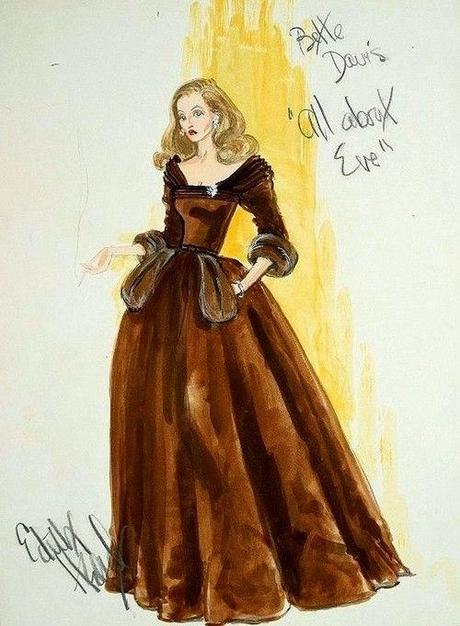
Edith Head costume sketch for Bette Davis
However, Edith Head, who designed Bette's costumes for the film, took Tallulah as an inspiration early on. Head later said that she had immersed herself in Tallulah's style when she went to work on Bette's wardrobe so that "everything looked as if it was made for her, yet the clothes complimented Bette." On the other hand, when a reporter asked Bette if her "throaty" voice was a parody of Tallulah's, she flatly denied it, adding, "Do you think we want to get sued?"In fact, the actress felt a strong sense of identification with the character of Margo Channing.~
And what about 'Eve' - was the frantic woman who'd telephoned Joe Mankiewicz in Venice in 1987 telling the truth?
A few years after she made that call, the woman, who was known as Martina Lawrence, traveled from her home in Venice to New York. While there, she contacted a journalist at the Daily News who specialized in celebrity profiles and had already done pieces on Celeste Holm and Joe Mankiewicz. Lawrence told him she wanted to tell her side of the story. The writer was interested and in the process of getting to know her, he arranged for a tea at Sardi's - and invited Mary Orr to come along. Orr had not seen the woman, formerly known as Ruth Hirsch, since 1946 when she barged, uninvited, into Orr's home. It seems she had just read The Wisdom of Eve in Cosmopolitan and was threatening to sue (that didn't happen and Orr went on to publish another story about Miss Harrington, More About Eve, in Cosmopolitan in 1951). Not surprisingly, the tea at Sardi's was contentious at times, with the two women bickering over what had happened in the long-distant past.
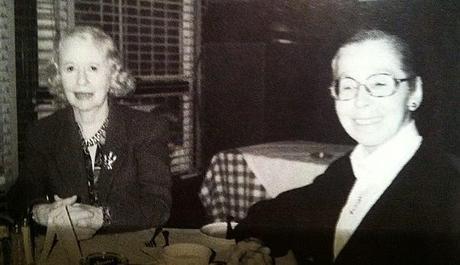
Mary Orr and Martina Lawrence at Sardi's in the early 1990s
Lawrence was in New York again in 1999, this time to see an old friend who had a supporting role in Marlene, a Broadway production starring Sian Phillips as Dietrich. By this time writer Sam Staggs was deep into his everything-you-ever-wanted-to-know book on All About Eve and, not wanting to miss his chance to meet the apparently 'real Eve,' flew to New York to interview her. The woman he met was in now her 70s, very thin, prickly and assertive. And theatrical. She told him she had been born in Chicago in 1921 and, perhaps because her mother was mentally unstable and abusive, had spent much of her childhood in orphanages. She had picked up her British-sounding accent in childhood, she told him, from watching movies.According to Martina Lawrence, she met Paul Czinner when she went to see The Two Mrs. Carrolls for the first time. She got to know him and began helping him hail cabs for Bergner after her performances. It wasn't long before she began working for the director and his wife. The situation started to unravel when Bergner caught Lawrence reading her part at a rehearsal with a new cast member one afternoon. Then, a letter arrived for the actress, purportedly from someone who had witnessed Lawrence's rehearsal performance and was awed by her talent. Bergner later said that she always thought Lawrence had written the letter herself. In any case, Lawrence surreptitiously snatched it from Bergner's dressing gown and soon found herself barred from the theater.
Though Bergner was no longer speaking to her, the younger woman soldiered on and soon entered the competition for the John Golden awards. She won one of four given and this eventually led to a brief Hollywood sojourn. As for her name change, Lawrence told Staggs it was Bergner who had, through an intermediary, recommended that she take a stage name - and suggested 'Martina Lawrence.' The name was that of one of the two characters Bergner portrayed in Stolen Life (the names were changed for the Bette Davis production).
Martina Lawrence insisted that she had never deceived Elisabeth Bergner, that the actress had imagined all of it. There were those who believed her and those who did not. One acquaintance who'd known her from her early Broadway years reported, with conviction, that Lawrence had also made her way into the inner circle of opera legend Renata Tebaldi and "played Eve Harrington to her" for a while. The friend indicated that this incident wasn't widely known because, in the lofty realm of opera, "Divas don't like to admit they've been had."
Sources:
All About All About Eve by Sam Staggs, St. Martin's Press (2000)
Dark Victory: The Life of Bette Davis by Ed Sikov, Henry Holt & Co. (2007)
New York Times obituary for Mary Orr, October 6, 2006
